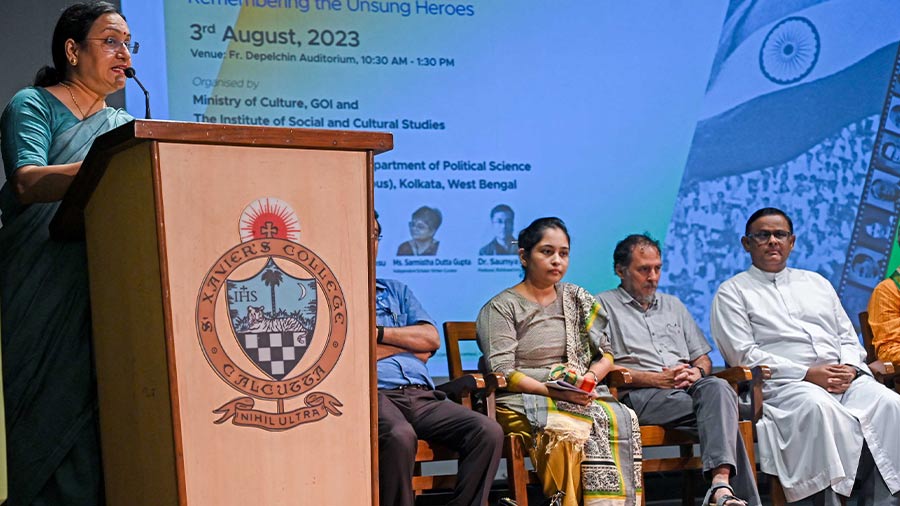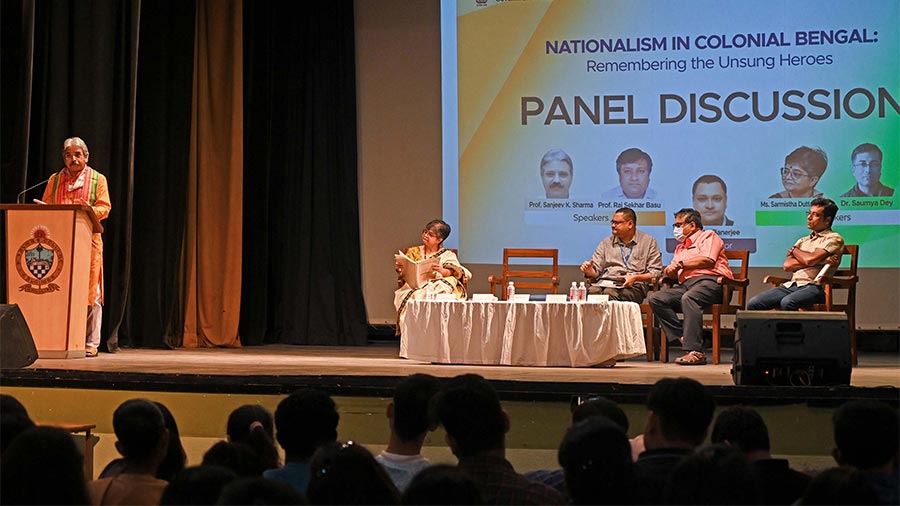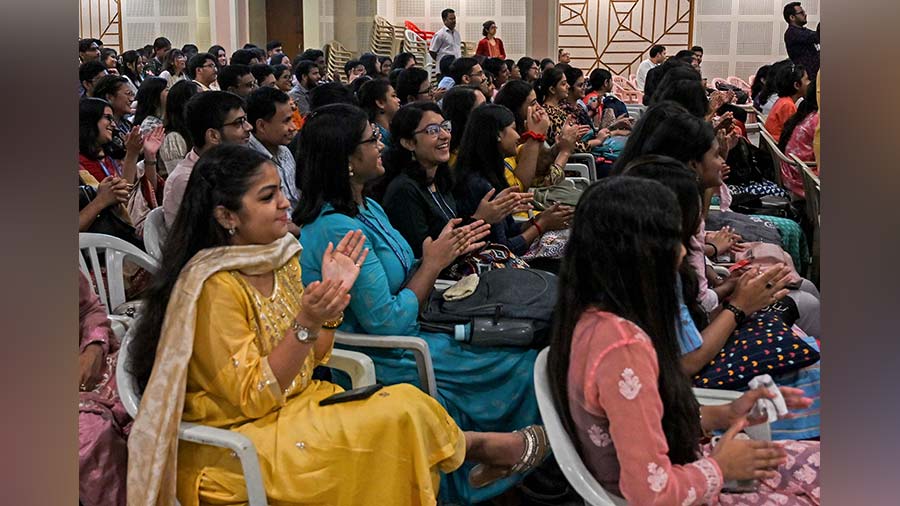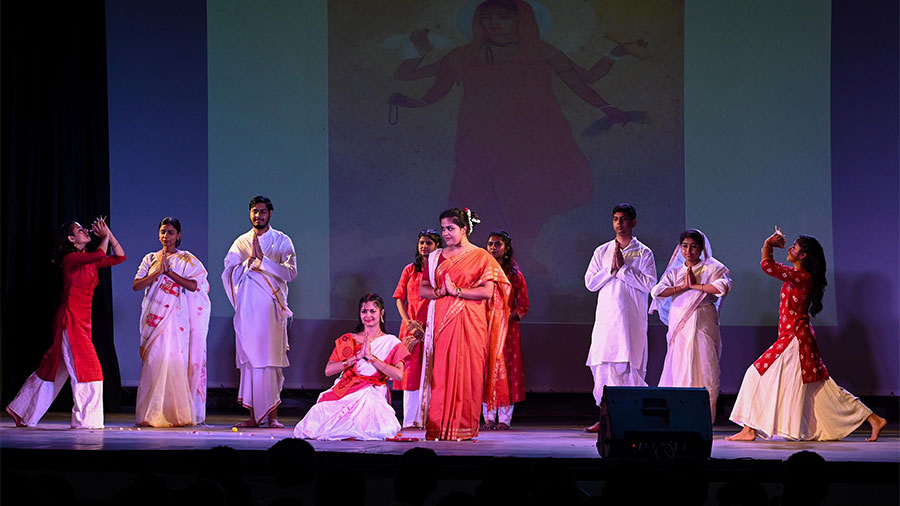While Netaji Subhas Chandra Bose, Surya Sen, Chittaranjan Das, Bagha Jatin among several others will be revered forever and are an integral part of our lives, there are many whose contributions to the freedom struggle have largely gone unnoticed.
Last month, the ministry of culture and the Institute of Social and Cultural Studies in collaboration with the post-graduate and research department of political science, St Xavier’s College (Autonomous), Kolkata, organised a seminar and extempore competition called Krantiteertha – Nationalism in Colonial Bengal: Remembering the Unsung Heroes.

Jhumpa Mukherjee, head of the department of political science, St Xavier’s College, Kolkata speaks
Honouring the legacy of revolutionaries
“Bengal was the epicentre of the freedom struggle and the cradle of nationalism. Bengal stormed into national consciousness riding the crest of the Swadeshi Movement. While mainstream history writing privileges a few as the shapers of history and portrays a handful of personalities as representatives of larger nationalistic aspirations, the contributions and struggles of the unsung heroes must be acknowledged widely. The revolutionary activities of such unsung heroes have emerged as the most extensive legacy of Swadeshi Bengal,” said Rev. Dr Dominic Savio, S.J., principal, St. Xavier’s College, in his inaugural address.
A similar sentiment was echoed by Dr Jhumpa Mukherjee, head of the department, political science, St. Xavier's College, Kolkata. “Many freedom fighters did not find the rightful place in public memory or historical memoirs. Krantiteertha attempts to capture some of the milestones of anti-colonial nationalism spanning Bengal which was the epicentre of revolutionary nationalism,” she said.

Sanjeev K. Sharma speaks of the important contribution of artists to the freedom struggle
The seminar began with the felicitation of speakers. The panel comprised noted academicians such as professor Sanjeev K. Sharma, former V-C, Mahatma Gandhi Central University, general secretary & treasurer, IPSA; Sarmistha Dutta Gupta, independent scholar, writer, and curator; Rajshekhar Basu, professor of history, Calcutta University; and Dr Saumya Dey, professor Rishihood University. The moderator for the session was Dr Arga Banerjee, professor department of English, St. Xavier’s College, Kolkata.
Often the revolutionary movement in Bengal is termed as “revolutionary terrorism”. For Dr Saumya Dey, the term is not only problematic but also “objectionable”. “Terrorism lacks discrimination, aiming solely to terrorise the society. This movement, however, didn't employ indiscriminate violence but focused on targeted assassinations of oppressive colonial officials. I prefer to call it ‘armed nationalistic radicalism’. The colonial administration was unaccountable to Indians, leading to paternalistic arbitrariness and brutality, spurring nationalist radicalism.” he noted.
Professor Rajshekhar Basu said: “The British officers wrote in their report that the revolutionaries were mostly misguided young men. That they were bereft of any intelligence of their own, perhaps brainwashed. Since they invoked Sri Krishna, Ma Kali, and Ma Durga, the British officials felt that their actions were as ‘bizarre as their religion’. The revolutionaries were inspired by the image of Mother India. A Mother India that reassures, provides in plentitude and caters to the demands of the angry and the poor. The revolutionaries often invoked gods and goddesses, especially lord Krishna, because they were influenced by his role as a political philosopher. The revolutionaries felt that if the British rulers were that oppressive, the answer to this oppression lay in reading the Gita which is Lord Krishna’s message to any beleaguered soul. The goddesses were respected and revered because they embodied shakti (power).”
Elaborating on why several Bengali revolutionaries are not remembered even though they had made significant contributions to the freedom struggle, Basu pointed out that many of them hailed from families that needed to have the cultural or social capital that would put them on the historical map.

The audience applauds in appreciation
Women too played their part
Not just men, women of Bengal were also at the forefront of the freedom struggle despite the idea of a revolutionary being constructed in terms of the culturally accepted idea of masculinity. “While masculinity remained high among the revolutionaries in the early 1920s, femininity certainly came to the fore by the mid-1920s and 1930s, questioning the prevalent patriarchal norms and structures,” said Professor Rajshekhar Basu.
Explaining women roles
For Sarmistha Dutta Gupta, the topic of unsung revolutionaries has not only been of academic interest but also of “deep personal interest" since her grandfather’s elder brother was a revolutionary who had been executed in the Presidency Jail in the Alipore bombing case in 1910. Her focus, however, was on the women revolutionaries from Bengal. She pointed out that in the histories of freedom movements that have been written so far concerning Bengal, women’s participation has largely been understood as respectable Hindu women’s political participation.
“No significant scholarly work in Bengal has challenged the existing knowledge hierarchies and shed new light on women's involvement quite like Suruchi Thapar-Björkert's book Women in the Indian National Movement: Unseen Faces and Unheard Voices, 1930-42. While we have extensively studied the roles of upper-caste women, what's intriguing is the oversight of their substantial physical labour, often dismissed as routine domestic chores when discussing their participation. For example, the countless hours spent by women cooking and nourishing male political activists and fellow fighters are never considered contributions. Additionally, we haven't explored the stereotypes silently shattered by women who managed households single-handedly while their male counterparts were incarcerated, lost their jobs due to anti-colonial activism, or had their family properties confiscated. Take Pratibha Waddedar, the mother of Pritilata Waddedar, for instance. Not only did she inspire and support her daughter's revolutionary aspirations, but after Pritilata's martyrdom in 1932, when her father and uncle both lost their government jobs, Pratibha Waddedar defied middle-class norms by venturing into employment during the 1930s. She trained as a midwife and visited homes to support her family, raising her younger children and even practising homoeopathy,” she remarked.
“Thankfully due to memorials and prison narratives left behind by educated women political workers like Kamala Das Gupta, Bina Das, Kalyani Das Bhattacharya, and a few others, we get to faintly hear the voices of a few women who came from humble backgrounds and suffered enormously in the hands of the police and it has been 76 years since we won our Independence, it is time to get rid of the sanitised versions of history where the nature of the death of small-town women does not remain obscured but gets recognised,” she concluded.

The students took part in an extempore competition
Prof. Sanjeev K. Sharma, highlighted the contribution of artists to the freedom struggle. “The purpose of this seminar is to celebrate the fact that every village, town, and city of the country has been a Krantiteertha against the 200 years of colonial rule. Just like we have discussed women revolutionaries who weren’t directly involved in the fight but were helping from behind the scenes, it is also important to note the contribution of the artists who were making films, writing books, and poems, and fighting to save the indigenous education systems. The biggest contribution to the freedom struggle has been from Bengal,” signed off Sharma.
The event also witnessed a lively extempore competition among the students and concluded with a cultural programme depicting Bengal’s struggle for freedom.
